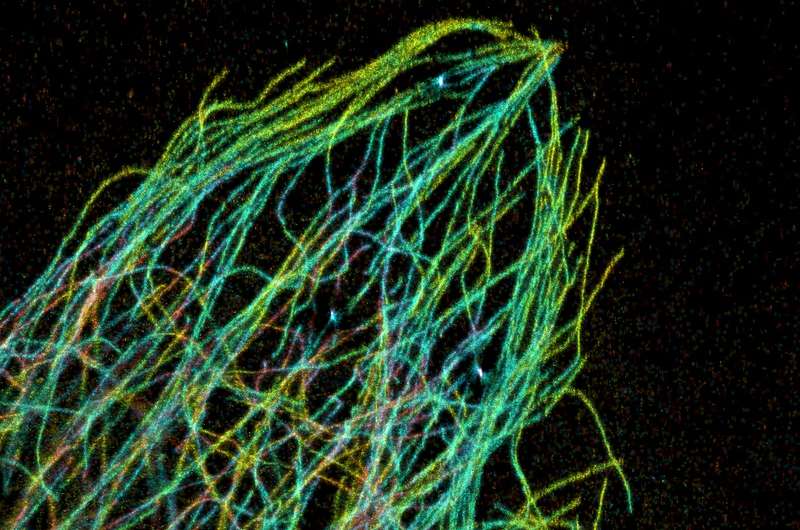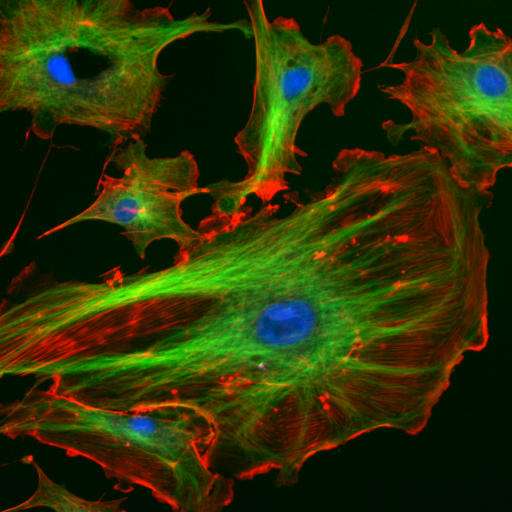New way to treat cancer and vessel diseases

Cell biologists from the Lomonosov Moscow State University discovered a new way of regulating of cell motility—this discovery will make possible development of new drugs for curing onco- and vessel diseases. The study was published in the Cytoskeleton journal.
The Lomonosov Moscow State University scientists find that protein kinase LOSK (discovered earlier in one of the A.N. Belozersky Institute Of Physico-Chemical Biology's laboratories) regulates an intracellular distribution of dynactin—a complex protein, necessary for retrograde intercellular transport. According to Anton Burakov, one of the study's authors, the results can help to create new medicine for cure oncology and vessel diseases.
Cellular motility defines a broad variety of vital processes for a cell and the whole organism: for instance, embryogenesis (an initial stage of the development of a fetus) and angiogenesis (formation of new blood vessels). Those processes require reorganization and polarization of actin (a protein of muscles) and microtubules—hollow cylindrical structures that form a eukaryotic cell's cytoskeleton. A cytoskeleton provides a cell with a mechanical frame, helps organelles' transportation and also enables cellular locomotion—contractile proteins are found not only in muscles, but also in other tissues of living organisms.
The brand new and previously unknown regulator of cell motility is the protein kinase LOSK (Long Ste20-like Kinase), also known as SLK. Like other protein kinases, SLK/LOSK modifies proteins by phosphorylation, which may change its fermentative activity, position in a cell and interaction with other proteins. SLK/LOSK was previously discovered in the A.N. Belozersky Institute Of Physico-Chemical Biology—a subdivision of MSU.

The biologists study the molecular mechanisms defining the architecture and structure of the main cell transport system—the microtubule network. Microtubules in a cell are like "roads" transporting particles—this transportation is effected with motor proteins (dynein and kinesins).
During the study, multiple genetic constructions were built using molecular cloning technology. Those constructions were further transfected into animal cells (mostly to the cells from a green monkey's kidney). The movements of genetically modified cells and its neighbors into experimental wound were filmed using a special microscope equipped with a heating system. Meanwhile, the morphology of cytoskeletal structures was also studied, as well as a content of a number of proteins in cytoplasm. The cells were also affected by specific inhibitors.
It was noticed that LOSK is able to regulate an intracellular distribution of dynactin— a complex protein necessary for an intracellular transportation. Dynactin regulates the activity of dynein and its connection to microtubules and a centrosome. A centrosome is the main microtubule organization center, playing a vital role in the cell division process. Usually, a cell contains one or two centrosomes, while malignant cells contain notably more.
Anton Burakov, Doctor of Science in biology, senior research fellow of the A.N. Belozersky Research Institute, comments: "The main result of the study is that we managed to separate two independent rows of events, started by SLK/LOSK protein, and to show that one of those processes leads to building a radial microtubule array, and the other—to directed cell movement. Previously, it was assumed that directed movement of cells depends on the microtubule architecture. Apart from embryogenesis and angiogenesis, cellular motility also defines the processes of cancerogenesis, wound healing and immune response. Microtubules pose a target to cytostatics - medicines used to cure cancer diseases. The conclusion of the study is that regulation of cellular movement is independent from regulation of a microtubule organizing center."
The study of cellular motility is important, as this process is crucial for vital biological activities of human and animals. Additionally, methods of regulation are obviously different in normal and tumor cells, which allows further research.
"Our results can already be used for further research in this field. Application of the results in medical practice (elaboration of certain inhibitors of motility for oncotherapy or specific motility stimulators for vessel diseases) depends on a corresponding legal basis," says Anton Burakov.
More information: Artem I. Fokin et al. SLK/LOSK kinase regulates cell motility independently of microtubule organization and Golgi polarization, Cytoskeleton (2016). DOI: 10.1002/cm.21276
Provided by Lomonosov Moscow State University


















